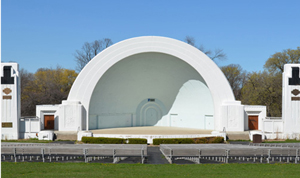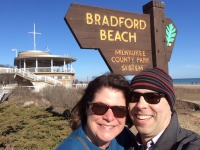It began as a unique birthday gift — a beautiful print of the Milwaukee County Parks with the promise we’d explore all 142 parks together before my next birthday.
Our goal was to understand the “essence” of each park we visited. Each park has its own personality, reflecting neighborhoods past and present, as well as unique natural and manmade features. Sometimes we hiked for hours across a variety of habitats and sometimes we took a 15-minute stroll along a sidewalk. No matter the size, every single one was active. Even in the freezing cold days of winter people were walking dogs, playing on playgrounds, gathering with friends, practicing sports and getting exercise. There is no question in my mind that parks are at the heart of our city’s neighborhoods, where people come together to enjoy each other’s company. Here are a few highlights of our experiences.
Our favorite natural encounters
Our first park, Franklin Savanna (also a State Natural Area), echoed with the calls of migrating Sandhill Cranes in mid-March. The forest itself was gorgeous. Buckthorn removal was in process, so the thinning understory gave way to the winter silhouettes of leafless oaks lining rolling hills and streams. There is no trail into Franklin Savannah, so the entry along a fencerow, then bush-whacking gave the immediate feel of a wilderness adventure.
We hiked the bluffs and forests of Grant and Warnimont Parks and the Seven Bridges Trail on December 30th. On this somewhat mild winter day we saw crystal icicles hanging from trees, striking views of Lake Michigan, a sky rich with colors of a low-hanging sun, rounded multicolored stones emerging from snow and ice along the shore — natural features that highlight Milwaukee’s beautiful location along the Lake Michigan shoreline.
On the west side, at Servite Park Preserve, we found a little natural oasis. Bird song reverberated through a little wetland, fox scat indicated the presence of some wildlife, and the looping trail took only about 15 minutes to walk. Another small park, Holler, hosts native gardens and lovely wooded trails circling a pond. By mid-June the pond was fully coated by a carpet of duck-weed making it an eerie bright green color.
Snapshots:
- A chorus of frogs painted a springtime soundscape in Bender Park in early April. Bender offers forests, wetlands and open fields along the bluff.
- We heard the echoing calls of a Great-Horned Owl at sunset in Wilson Park.
- In Algonquin Park we had close views of a Cooper’s Hawk and Hairy Woodpecker.
- We hiked around Mallard Lake in Whitnall Park and found the trail lined with beautiful Jack-in-the-Pulpit wildflowers.
- Falk Park showcased a variety of habitats: Beech-Maple and Hickory-Oak forests, prairies and wetlands. Trails are well maintained and offer a variety of native plants – a great place to bring your wildflower guides.
- In Kohl Park we explored beautiful hiking trails traversing a variety of terrain, then crossed over to Mequon Nature Preserve and its lookout tower.
Coolest manmade features
There are about as many baseball diamonds (including little league, softball and hardball) as there are parks: many more than we anticipated. While there were other sports amenities (golf, disk golf, basketball, soccer, football, lawn bowling… even a cricket field!), the parks as a whole demonstrate a strong leaning toward baseball. And while this certainly is a nod to America’s favorite pastime, we did not see any games in progress during our year.
 Two parks are tied for having the best band shell: Washington Park and Humboldt Park. Washington Park’s grandiose “Temple of Music” had its first performances in 1938, according to Laurie Muench Albano’s, “Images of America: Milwaukee County Parks”. We were there during a concert and music filled the sloping amphitheater, making for a memorable evening. Humboldt Park’s band shell is playful and less formal, with a bright red sloping roof. We were there off season, enjoying the view that concert goers would have in a few months alongside children sledding down the back side of the amphitheater.
Two parks are tied for having the best band shell: Washington Park and Humboldt Park. Washington Park’s grandiose “Temple of Music” had its first performances in 1938, according to Laurie Muench Albano’s, “Images of America: Milwaukee County Parks”. We were there during a concert and music filled the sloping amphitheater, making for a memorable evening. Humboldt Park’s band shell is playful and less formal, with a bright red sloping roof. We were there off season, enjoying the view that concert goers would have in a few months alongside children sledding down the back side of the amphitheater.
Kosciuszko Park, whose skyline is dominated by the Basilica of St Josaphat, has a unique entry to the swimming area. Even in the heart of winter, the outdoor pool facility brought to mind a warm Mediterranean breeze. We will certainly want to visit again when the pool is open!
Snapshots:
- Sheridan Park’s model boat launch area and Lindsay Park’s cricket pitch are both worth noting because we didn’t know such things existed in our county parks.
- The Statue of Scottish poet Robert Burns in a small triangle park on the east side, Burns Commons, is decorated with poems.
- In Mitchell Park, Jacques Vieau’s settlement is marked on a ridge with lovely views overlooking the Menomonee River Valley and is adjacent to the Green Bay Packers field donated to Journey House and the County Parks.
Just because
Perhaps because I’d never been to them before, I was charmed by two parks: Greenfield and Jackson. At Greenfield Park, the pavilion overlooks a beautiful, large lagoon and gentle hills lined with forest and fields. There is a water park behind the pavilion and a golf course to the north, both serving as popular summer play spots. Jackson Park, about half the size of Greenfield, is also blessed with a lovely lagoon and pavilion. At the pavilion, we met Jason, a very friendly county employee who gave us a quick tour as he waited for renters to arrive. As we explored the park, we found wooded hiking trails, covered picnic areas, bridges over streams and an outdoor pool. It was sunny but cold in mid-January, and the park was being enjoyed by quite a few people.
And the stories could go on. We’d love to do it again, next time visiting each park in a different season. Perhaps we will.
Have you had an adventure in the parks? If not, why not start at one of our Urban Ecology Center branches, then venture out from there. Share your stories in the comments below. We’d love to hear them. Hopefully together we can inspire more people to get out, get exercise and get energized by this beautiful green city.





